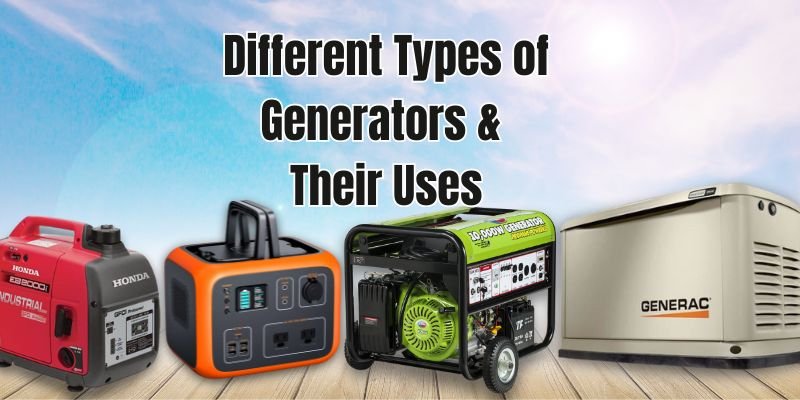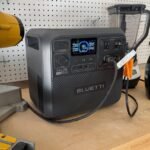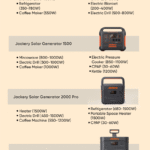Disclosure: This post contains affiliate links and I will be compensated if you make a purchase after clicking through my links. Learn More
Your generator won’t start due to fuel issues, spark plug problems, or a dead battery. Check these components first.
Generators are vital during power outages, providing essential backup. A generator failing to start can be frustrating and inconvenient. Several factors could be behind this issue. Common reasons include an empty fuel tank, clogged fuel lines, or a malfunctioning spark plug.
A dead battery or dirty air filter can also prevent the generator from starting. Regular maintenance and timely checks can help identify and fix these problems. Understanding these common issues can save you time and hassle, ensuring your generator runs smoothly when you need it most. Proper care and troubleshooting keep your generator reliable and efficient.
Common Reasons For Generator Failure
Generators are big helpers when the power goes out. They keep our homes bright and our fridges cold. But sometimes, these machines don’t work when we need them most. Let’s talk about why generators might not start and what we can do about it.
Fuel Issues
Fuel problems are one of the main reasons generators don’t start. Think of fuel as food for your generator. Without good fuel, it can’t run. Here’s what to look out for:
Empty fuel tank: Always check if there’s enough fuel in the tank. It’s easy to forget to fill it up, especially if you haven’t used the generator in a while.
Old fuel: Fuel can go bad over time. If it’s been sitting in the generator for months, it might not work well. Try to use fresh fuel when you can.
Fuel leaks: Sometimes, fuel can leak out of the generator. Look around the fuel tank and on the ground under the generator. If you see any wet spots, you might have a leak.
To keep fuel issues away:
- Fill up the fuel tank before you need to use the generator.
- Use new fuel if the old fuel has been sitting for more than a month.
- Check for leaks regularly and fix them as soon as you find them.
Battery Problems
Just like a car, generators often need a battery to get started. Battery issues can stop your generator from working. Here’s what to check:
Weak battery: Over time, batteries lose their power. If your generator’s battery is old, it might not have enough juice to start the engine.
Dirty connections: The spots where the battery connects to the generator can get dirty or rusty. This can stop the power from flowing right.
Loose connections: Sometimes, the battery cables can come loose. This is like unplugging a lamp – no power can flow.
To fix battery problems:
- Clean the battery connections with a wire brush.
- Make sure all the cables are tight and in the right place.
- If your battery is more than 3 years old, think about getting a new one.
Spark Plug Malfunctions
The spark plug is a small but mighty part of your generator. It makes the spark that starts the engine. If it’s not working right, your generator won’t start. Here’s what can go wrong:
Dirty spark plug: Over time, spark plugs can get covered in gunk. This stops them from making a good spark.
Worn-out spark plug: Like all parts, spark plugs wear out. If yours is old, it might not work well anymore.
Gap issues: There’s a small space in the spark plug where the spark jumps. If this gap is too big or too small, the spark won’t work right.
To keep your spark plug working well:
- Check the gap with a spark plug gap tool and adjust if needed.
- Take out the spark plug and look at it every few months.
- If it’s dirty, clean it with a wire brush.
- If it looks worn or damaged, put in a new one.
Checking The Fuel System
If you’ve looked at all the other parts and your generator still won’t start, it’s time to check the fuel system more closely. The fuel system is like the veins of your generator, carrying fuel where it needs to go.
Fuel Level
First, let’s talk about how much fuel is in your generator:
Using the fuel gauge: Most generators have a gauge that shows how much fuel is left. It’s like the gas gauge in a car. Check this first to make sure you have enough fuel.
Visual check: If your generator doesn’t have a gauge, you might need to look inside the fuel tank. Use a flashlight to see how much fuel is in there.
Filling up: If the fuel level is low, fill it up. But be careful not to overfill – leave some space at the top of the tank.
Fuel Quality
The quality of your fuel matters a lot. Bad fuel can cause big problems:
Color check: Good fuel is usually clear or slightly yellow. If it’s dark or cloudy, it might be old.
Smell test: Fresh fuel has a strong, distinct smell. If it smells sour or odd, it might have gone bad.
Water in the fuel: Sometimes, water can get into your fuel. This is really bad for your generator. If you see water droplets or a layer of water in the fuel, you’ll need to drain it and refill with fresh fuel.
To keep your fuel fresh:
- Try to use fuel within a month of buying it.
- Add a fuel stabilizer if you need to store fuel for longer.
- Keep fuel in a clean, sealed container in a cool, dry place.
Fuel Line Blockages
The fuel lines carry fuel from the tank to the engine. If these get blocked, your generator won’t work:
Kinks in the line: Sometimes, fuel lines can get bent or kinked. This stops fuel from flowing. Check all the lines and straighten any bends.
Debris in the line: Dirt or other small bits can get into the fuel lines. This can stop fuel from getting through. You might need to disconnect the lines and blow them out with compressed air.
Fuel filter check: The fuel filter keeps dirt out of the engine. But if it gets too dirty, it can block fuel flow. Check your fuel filter and replace it if it looks clogged.
Inspecting The Battery
One common reason a generator won’t start is a battery issue. Checking the battery should be your first step. A few simple inspections can help you identify the problem.
Battery Charge
A dead battery can stop your generator from starting. Use a multimeter to check the battery voltage. The reading should be around 12.6 volts for a fully charged battery. If the voltage is low, charge the battery. If the battery doesn’t hold a charge, it may need replacement.
Corroded Terminals
Corrosion on battery terminals can disrupt the connection. Inspect the terminals for any white or greenish residue. If you see corrosion, clean the terminals with a wire brush. Use a mixture of baking soda and water to neutralize any acid. Apply petroleum jelly to the terminals after cleaning to prevent future corrosion.
Loose Connections
Loose battery connections can prevent the generator from starting. Check the battery cables for tightness. Ensure both positive and negative cables are securely fastened. A loose connection can lead to a poor electrical flow. Tighten any loose connections with a wrench. Also, inspect the cables for any signs of wear or damage. Replace damaged cables if necessary.
Assessing The Spark Plug
Is your generator refusing to start? The spark plug might be the culprit. A spark plug provides the necessary spark to ignite the fuel. So, assessing it is crucial.
Spark Plug Condition
First, check the spark plug condition. Remove the spark plug from the generator. Look for any signs of wear or damage. A damaged spark plug can prevent your generator from starting.
Inspect the tip for any black soot or carbon buildup. This indicates poor combustion and requires attention. If the tip is wet, the spark plug might be flooded with fuel.
Proper Gap
The proper gap is essential for efficient functioning. Use a gap gauge to measure the gap between the electrodes. The gap should match the manufacturer’s specifications.
If the gap is too wide or too narrow, the spark plug won’t function properly. Adjust the gap using the tool provided with the gap gauge.
Cleaning Or Replacing
If the spark plug is dirty, consider cleaning or replacing it. Use a wire brush to clean any debris or buildup. For stubborn grime, a spray cleaner can help.
If the spark plug is damaged or excessively dirty, replace it with a new one. Always use the correct spark plug type specified by the manufacturer.
Here’s a quick reference table:
| Condition | Action |
|---|---|
| Worn or Damaged | Replace Spark Plug |
| Black Soot or Carbon Buildup | Clean with Wire Brush |
| Wet Tip | Check for Fuel Flooding |
| Incorrect Gap | Adjust to Specification |
By following these steps, you can ensure your spark plug is in top condition. This increases the chances of your generator starting smoothly.
Examining The Air Filter
Is your generator refusing to start? The air filter could be the culprit. The air filter keeps dirt and debris out of the engine. A dirty filter can block airflow. This can lead to starting problems. Let’s look closer at the air filter.
Clogged Filters
A clogged filter is a common issue. Dirt and debris build up over time. This restricts airflow to the engine. Less air means the engine can’t start. You need to check the filter regularly. Look for signs of dirt and clogging.
- Dark, dirty appearance
- Reduced airflow when you blow through it
- Visible debris stuck in the filter
Cleaning Techniques
Cleaning the air filter can solve starting problems. Follow these steps:
- Remove the air filter from the generator.
- Tap it gently to remove loose dirt.
- Use a brush to clean stubborn dirt.
- Wash it with soapy water if it’s washable.
- Let it dry completely before reinstalling.
A clean filter ensures proper airflow. This helps the engine run smoothly.
Replacing The Filter
Sometimes, cleaning is not enough. If the filter is too dirty or damaged, you need a new one. Follow these steps to replace it:
- Purchase the correct filter for your generator model.
- Remove the old filter carefully.
- Install the new filter in the same position.
- Secure it properly to avoid air leaks.
Replacing the filter ensures the engine gets clean air. This can solve many starting issues.
Evaluating The Oil Level
One common reason your generator won’t start could be the oil level. Evaluating the oil level can pinpoint issues that prevent the generator from running smoothly. Understanding oil level and quality can save you time and effort.
Low Oil Level
If the oil level is low, your generator may not start. Generators have sensors that detect low oil levels. These sensors prevent the engine from running to avoid damage.
To check the oil level, use the dipstick. Follow these steps:
- Turn off the generator.
- Remove the dipstick and wipe it clean.
- Insert the dipstick back and pull it out again.
- Check the oil mark. Ensure it is between the low and full marks.
If the oil is below the low mark, add more oil. Use the recommended type specified in your generator’s manual.
Oil Quality
Even if the oil level is adequate, oil quality can be an issue. Dirty or old oil can cause problems. Check the oil’s color and consistency. Clean oil is usually amber and smooth.
Signs of poor oil quality include:
- Dark color
- Thick texture
- Presence of debris
Replace the oil if it looks dirty or old. Poor oil quality can affect engine performance.
Oil Change Procedures
If your oil is dirty or old, change it. Follow these steps to change the oil:
- Turn off the generator and let it cool.
- Place a container under the oil drain plug.
- Remove the drain plug and let the oil drain out.
- Replace the drain plug.
- Remove the oil cap and add new oil.
- Check the oil level using the dipstick.
Ensure you use the correct oil type. Always refer to your generator’s manual.
Reviewing The Ignition System
Is your generator not starting? The ignition system might be the culprit. This system is crucial for starting your generator. Let’s dive into the key components.
Ignition Coil Issues
The ignition coil generates the spark for starting. If faulty, the generator won’t start. Check for visible damage. Look for cracks or corrosion. Use a multimeter to test the coil. It should show a specific resistance. Refer to your manual for exact numbers.
Wiring Problems
Wiring problems can disrupt the ignition system. Inspect all wires for damage. Look for frayed or broken wires. Check connections for tightness. Loose connections can prevent the generator from starting. Use a continuity tester to ensure all wires are functional.
Testing The System
Testing ensures all parts of the ignition system work. Follow these steps:
- Turn off the generator.
- Disconnect the spark plug.
- Check the spark plug for damage.
- Reconnect the spark plug and ignition coil.
- Use a multimeter to test the ignition coil.
If any part fails, replace it. Regular testing can prevent future issues.

By checking all these parts of your generator, you can often find and fix the problem. This way, your generator will be ready to keep your lights on and your home running when you need it most. Remember, if you’re not sure about fixing something yourself, it’s always okay to ask for help from a professional.
Professional Help
Professional help is crucial when your generator won’t start. Sometimes, you need an expert. They can diagnose and fix problems. This section explores when to call a technician, maintenance tips, and how to find reliable service.
When To Call A Technician
- Strange Noises: If your generator makes unusual sounds, call a technician.
- Fuel Issues: Problems with fuel systems need professional help.
- Electrical Problems: If your generator has electrical issues, contact an expert.
- Repeated Failures: Frequent starting failures require technician intervention.
Maintenance Tips
- Regular Inspections: Inspect your generator regularly for any issues.
- Oil Changes: Change the oil as per the manufacturer’s guidelines.
- Clean Air Filters: Replace or clean air filters to ensure smooth operation.
- Fuel Quality: Use high-quality fuel to prevent clogs and damage.
Finding Reliable Service
- Check Reviews: Look for reviews online to find reliable technicians.
- Ask for Recommendations: Get suggestions from friends and family.
- Verify Credentials: Ensure the technician has proper certifications.
- Compare Prices: Get quotes from multiple services to find the best deal.
Professional help ensures your generator runs smoothly. Regular maintenance prevents major issues. A reliable service provider is essential for repairs and upkeep.
Frequently Asked Questions
Why Won’t My Generator Start?
A generator might not start due to low fuel, a dead battery, or a clogged carburetor.
How Do I Troubleshoot My Generator?
Check fuel levels, inspect the spark plug, and ensure the choke is in the correct position.
What Causes A Generator To Not Start?
Common causes include stale fuel, clogged air filters, or faulty spark plugs.
How Often Should I Maintain My Generator?
Regular maintenance is recommended every 6 months or after 100 hours of use.
Final Words
Ensuring your generator starts involves checking fuel, oil, spark plugs, and the battery. Regular maintenance is key to avoiding issues. Understanding common problems can save time and money. If your generator still won’t start, consider professional help. A reliable generator is crucial for uninterrupted power supply.








